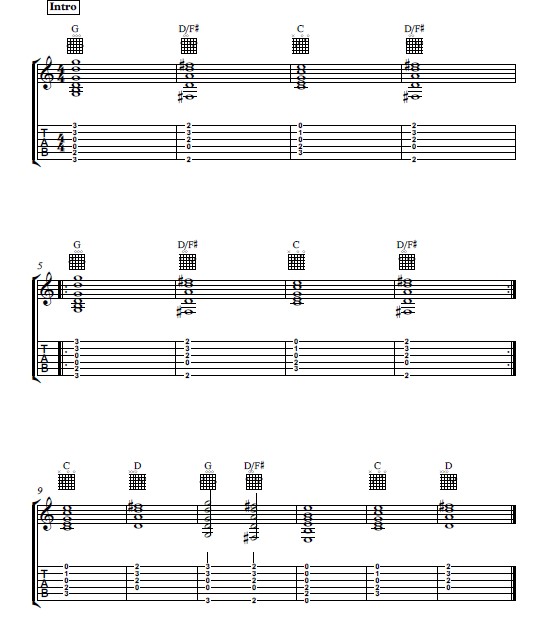https://www.youtube.com/watch?feature=player_embedded&v=pcgx803Z4dY
 How’s it going everybody?
My name is John McClennan and I’m here
today with guitarcontrol.com, really
excited to bring you this video.
Today we’re going to look at sort of
like a country comping or a Chet Atkins
style, Merl Travis sort of rhythm playing.
I like to call it the boom-chick because
you get the sound…
So let’s talk about breaking this down.
For me, I came from more of a jazz
background so when you have comping
you’re looking at sort of stuff like…
That kind of rhythm playing. Now, this
sound is completely different. And so
let’s go over the chords that we’re
going to use in this example.
We have an E7, and this is just like
if you made a C chord on the 5th fret
and then you just add your pinkie.
I love this chord and it’s just so easy
to get if you know C. You’re just adding
one note to it.
And then we’re going to start here and
play that chord and then let’s talk about
the right hand here, because what I’m doing
is I’m actually palm muting. And that’s where
I lay this part of my hand back here where the
bridge and the strings meet. So I get this.
It will sort of pop-out. If you’re too far
forward it’s not going to work. you’ve got to
go right back here.
Again, I’m going to play the root note with
my pick and then I’m going to strum the rest
of the chord and I’m going to mute the strings
so you get this sort of sound. Now it’s not —
some people think it’s pick and then fingers,
but it’s actually all pick and you’ve got to
just mute it to death here.
Then what you’re going to do is you’re going to
take your third finger and you’re going to
alternate bass notes. You’re going to play once
here and then you’re going to drop it down to
the low string, 7th fret. Now my pick is going
to play that note, bass note, chord, bass note,
chord, all palm muted.
The next chord, A7 and then I take my first finger
off to get the low E in there. Again, all muted bass
notes. It’s the same thing, boom-chick.
Then I’m going to play D7 which is exactly the same
as E7, just two frets lower. And then G7, which is
exactly the same as A7, but two frets lower and I’m
not going to use the open string this time.
Here what I’m going to do is I’m going to play from
the low 6th string and then strum it and I’m going
to play the 5th string so it alternates like this.
So you’ve got the root of the chord and the 5th.
It reminds me of a really silly joke. How many country
bass players does it take to screw in a light bulb?
One, five. So that comes from the root or the 5th of
the chord that the bass player is always playing.
Again, that’s where our boom-chick is coming from.
Let’s go through the whole thing. You’ll want to
just turn on the click and work on just getting
that real powerful sound.
So be sure to click the links below for the tab and
we’ll see you in the next video. Have fun practicing
that. See you later.
How’s it going everybody?
My name is John McClennan and I’m here
today with guitarcontrol.com, really
excited to bring you this video.
Today we’re going to look at sort of
like a country comping or a Chet Atkins
style, Merl Travis sort of rhythm playing.
I like to call it the boom-chick because
you get the sound…
So let’s talk about breaking this down.
For me, I came from more of a jazz
background so when you have comping
you’re looking at sort of stuff like…
That kind of rhythm playing. Now, this
sound is completely different. And so
let’s go over the chords that we’re
going to use in this example.
We have an E7, and this is just like
if you made a C chord on the 5th fret
and then you just add your pinkie.
I love this chord and it’s just so easy
to get if you know C. You’re just adding
one note to it.
And then we’re going to start here and
play that chord and then let’s talk about
the right hand here, because what I’m doing
is I’m actually palm muting. And that’s where
I lay this part of my hand back here where the
bridge and the strings meet. So I get this.
It will sort of pop-out. If you’re too far
forward it’s not going to work. you’ve got to
go right back here.
Again, I’m going to play the root note with
my pick and then I’m going to strum the rest
of the chord and I’m going to mute the strings
so you get this sort of sound. Now it’s not —
some people think it’s pick and then fingers,
but it’s actually all pick and you’ve got to
just mute it to death here.
Then what you’re going to do is you’re going to
take your third finger and you’re going to
alternate bass notes. You’re going to play once
here and then you’re going to drop it down to
the low string, 7th fret. Now my pick is going
to play that note, bass note, chord, bass note,
chord, all palm muted.
The next chord, A7 and then I take my first finger
off to get the low E in there. Again, all muted bass
notes. It’s the same thing, boom-chick.
Then I’m going to play D7 which is exactly the same
as E7, just two frets lower. And then G7, which is
exactly the same as A7, but two frets lower and I’m
not going to use the open string this time.
Here what I’m going to do is I’m going to play from
the low 6th string and then strum it and I’m going
to play the 5th string so it alternates like this.
So you’ve got the root of the chord and the 5th.
It reminds me of a really silly joke. How many country
bass players does it take to screw in a light bulb?
One, five. So that comes from the root or the 5th of
the chord that the bass player is always playing.
Again, that’s where our boom-chick is coming from.
Let’s go through the whole thing. You’ll want to
just turn on the click and work on just getting
that real powerful sound.
So be sure to click the links below for the tab and
we’ll see you in the next video. Have fun practicing
that. See you later.




